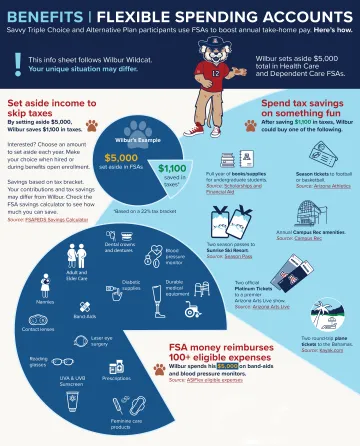A flexible spending account (FSA) allows you to set aside money pre-tax to use for qualified medical expenses, childcare, or adult and older adult care.
FSA Options
Are you curious about the different health savings account options? Review this comparison chart to make the best decision for you.
Health Care FSA
Co-pays | Deductibles | Medical, dental and vision expenses | Over-the-counter drugs | Illness-related transportation
Annual contribution max: $3,200/participant
Year-to-year rollover: $640 max
New for 2026: $3,300/participant with $660 roll over max.
Deadline to submit claims: April 30 of the following year
Optional debit card: Use the debit card to pay directly for eligible expenses. Learn more about debit cards.
Note: Enrollees in the High Deductible Health Plan with Health Savings Account may not enroll in the full Health Care FSA, but may enroll instead in the Limited Health Care FSA. The Limited Health Care FSA covers expenses related to dental, vision or out-of-network preventive care services.
Dependent Care FSA*
Childcare | Babysitters** | Nannies | Day camps | Elder care
Annual contribution max: $5,000/household ($2,500 for married, filing separately); this total also includes monies reimbursed or subsidized through the Childcare Choice Employee program and the Back-Up Care program, so please plan accordingly.
New for 2026: $7,500/household ($3,750 for married, filing separately)
Year-to-year rollover: 2.5-month grace period (contributions in a calendar year can be applied to expenses incurred through March 15 of the following year).
Deadline to submit claims: April 30 of the following year
Who is a dependent? (See full definition in the appendix):
- A child under the age of 13;
- A family member or adult who is unable to care for themselves, shares your residence and meets income requirements
* Expenses must be incurred to enable you and your spouse to attend work or school.
** Babysitting cannot be reimbursed if provided by your spouse or one of your own dependent children.
FSA plans undergo required IRS non-discrimination testing to ensure that highly compensated individuals are not disproportionately advantaged. If the university’s plans were not to meet the non-discrimination guardrails throughout a calendar year, households with a household income of more than $150,000 may be required to reduce FSA contributions.
Choosing Your Contribution Amount
When you enroll in an FSA, you must elect an amount to withhold for the plan year. This amount is based on your estimate of your family's annual health and/or dependent-care expenses.
The amount you withhold is "use it or lose it." To avoid losing unused funds at the end of the year, we recommend making conservative estimates of your expenses. The Dependent Care FSA has a grace period, allowing you to claim expenses incurred through March 15 of the following year. The Health Care FSA allows some rollover from one year to the next, but the amount is capped. The Dependent Care FSA has no rollover.
How To Change Your Contribution Amount
You may only change your elected contribution amount in the following situations.
Open Enrollment: Usually occurs in October and November
Qualifying Life Event*:
- Change in family (marriage, birth, etc.)
- Change in employment status
- Change in dependent eligibility
All qualifying life events are listed on the Change Form (PDF).
*You must request changes within 31 days of the event.
Note for Dependent Care FSA participants who participate in the Childcare Choice Program: Beginning January 2027, Childcare Choice is moving to a calendar-year schedule. This means you'll have available funding for July–December 2026 (final fiscal year) and January–December 2027 (first calendar year) close together—possibly giving you approximately $1,000 extra in late 2026. Consider this additional funding when electing your 2026 Dependent Care FSA to avoid overcontributing. The new $7,500 limit, combined with your control over reimbursement timing, provides flexibility to manage the transition.
How To Submit Claims
Our FSA plan administrator: ASIFlex
asiflex.com | 800-659-3035 | asi@asiflex.com
How To Submit Claims
- ASIFlex website
- ASIFlex mobile app (Google Play or App Store)
- By mailing or faxing the claim form (PDF)
- By recurring direct pay (Dependent care FSA only)
Appendix: Plan Documents and Definitions
- Participant Plan Information (PDF)
- Describes plan provisions as well as qualifying and non-qualifying expenses
- IRS Publication 502 (PDF)
- Filing for medical and dental expenses
- IRS Publication 503 (PDF)
- Filing for childcare and dependent-care expenses
Forms
For purposes of claiming expenses under the FSA Dependent Care plan, a qualifying person must be:
- Your dependent child who was (a) under age 13 when the care was provided, (b) for whom you have custody more than 50% of the year, and (c) whom you can claim as an exemption on your federal income tax return; or
- Your dependent (child older than age 13, spouse, parent, or other adult for whom you have custodial responsibility) who (a) is physically or mentally unable to care for himself or herself, (b) shares the same residence with you, and (c) has an income less than the federal exemption amount.

